Tracking the Construction Land Expansion and Its Dynamics of Ho Chi Minh City Metropolitan Area in Vietnam
Abstract
1. Introduction
2. Study Area, Data Sources, and Research Methodology
2.1. Study Area
2.2. Data Sources
2.3. Research Methodology
2.3.1. Landscape Expansion Index
2.3.2. Land-Use Dynamics
2.3.3. Center of Gravity Transfer Model
2.3.4. Logistic Regression
3. Expansion of Construction Land in the Metropolitan Area
3.1. Characteristics of Construction Land Expansion Rate Changes
3.2. Spatial Structural Characteristics of Construction Land Expansion
3.3. The Characteristics of Land-Use Type Conversion
4. Driving Forces of Construction Land Expansion
4.1. Macroscopic Factors
4.1.1. Globalization and FDI
4.1.2. Urbanization and Industrialization
4.2. Quantitative Analysis
5. Discussion
6. Conclusions and Policy Implications
6.1. Conclusions
6.2. Policy Implications
Author Contributions
Funding
Data Availability Statement
Conflicts of Interest
Abbreviations
| FDI | Foreign Direct Investment |
| LEI | Landscape Expansion Index |
References
- Firman, T. The restructuring of Jakarta Metropolitan Area: A “global city” in Asia. Cities 1998, 15, 229–243. [Google Scholar] [CrossRef]
- Tran, D.; Pla, F.; Latorre-Carmona, P.; Myint, S.; Caetano, M.; Kieu, H. Characterizing the relationship between land use land cover change and land surface temperature. ISPRS J. Photogramm. Remote Sens. 2017, 124, 119–132. [Google Scholar] [CrossRef]
- Kalnay, E.; Cai, M. Impact of urbanization and land-use change on climate. Nature 2003, 423, 528–531. [Google Scholar] [CrossRef]
- Cohen, B. Urbanization in developing countries: Current trends, future projections, and key challenges for sustainability. Technol. Soc. 2006, 28, 63–80. [Google Scholar] [CrossRef]
- Seto, K.; Güneralp, B.; Hutyra, L. Global forecasts of urban expansion to 2030 and direct impacts on biodiversity and carbon pools. Proc. Natl. Acad. Sci. USA 2012, 109, 16083–16088. [Google Scholar] [CrossRef]
- Fang, C.; Yu, D. Urban agglomeration: An evolving concept of an emerging phenomenon. Landsc. Urban Plan. 2017, 162, 126–136. [Google Scholar] [CrossRef]
- Fang, C.; Yu, X.; Zhang, X.; Fang, J.; Liu, H. Big data analysis on the spatial networks of urban agglomeration. Cities 2020, 102, 102735. [Google Scholar] [CrossRef]
- Scott, A. Globalization and the rise of city-regions. Eur. Plan. Stud. 2001, 9, 813–826. [Google Scholar] [CrossRef]
- Yan, J.; Wang, J.; Su, F.; Liu, B. Morphology changes and the expansion of major port cities in the Philippines from 1990 to 2020. Cities 2024, 147, 104818. [Google Scholar] [CrossRef]
- Hara, Y.; Hiramatsu, A.; Honda, R.; Sekiyama, M.; Matsuda, H. Mixed land-use planning on the periphery of large Asian cities: The case of Nonthaburi Province, Thailand. Sustain. Sci. 2010, 5, 237–248. [Google Scholar] [CrossRef]
- Mulya, S.P.; Hudalah, D.; Prilandita, N.; Sakti, A.D. Spatio-temporal changes in agricultural land and rural–urban transitions in Greater Jakarta, Indonesia. Reg. Environ. Change 2024, 24, 145. [Google Scholar] [CrossRef]
- Rustiadi, E.; Pravitasari, A.E.; Setiawan, Y.; Mulya, S.P.; Pribadi, D.O.; Tsutsumida, N. Impact of continuous Jakarta megacity urban expansion on the formation of the Jakarta-Bandung conurbation over the rice farm regions. Cities 2021, 111, 103000. [Google Scholar] [CrossRef]
- Yang, Y.; Zhang, D.; Nan, Y.; Liu, Z.; Zheng, W. Modeling urban expansion in the transnational area of Changbai Mountain: A scenario analysis based on the zoned land use scenario dynamics-urban model. Sustain. Cities Soc. 2019, 50, 101622. [Google Scholar] [CrossRef]
- Manley, E.; Ogneva-Himmelberger, Y.; Ruelle, M.; Hanumantha, R.; Mazari-Hiriart, M.; Downs, T.J. Land-cover change and urban growth in the Mexico-Lerma-Cutzamala Hydrological Region, 1993–2018. Appl. Geogr. 2022, 147, 102785. [Google Scholar] [CrossRef]
- Wilson, E.H.; Hurd, J.D.; Civco, D.L.; Prisloe, M.P.; Arnold, C. Development of a geospatial model to quantify, describe and map urban growth. Remote Sens. Environ. 2003, 86, 275–285. [Google Scholar] [CrossRef]
- Berling-Wolff, S.; Wu, J. Modeling urban landscape dynamics: A case study in Phoenix, USA. Urban Ecosyst. 2004, 7, 215–240. [Google Scholar] [CrossRef]
- Dadashpoor, H.; Azizi, P.; Moghadasi, M. Analyzing spatial patterns, driving forces and predicting future growth scenarios for supporting sustainable urban growth: Evidence from Tabriz metropolitan area, Iran. Sustain. Cities Soc. 2019, 47, 101502. [Google Scholar] [CrossRef]
- Savini, F. Towards an urban degrowth: Habitability, finity and polycentric autonomism. Environ. Plan. A Econ. Space 2021, 53, 1076–1095. [Google Scholar] [CrossRef]
- Huang, J.; Lu, X.X.; Sellers, J.M. A global comparative analysis of urban form: Applying spatial metrics and remote sensing. Landsc. Urban Plan. 2007, 82, 184–197. [Google Scholar] [CrossRef]
- Kuang, W.; Chi, W.; Lu, D.; Dou, Y. A comparative analysis of megacity expansions in China and the U.S.: Patterns, rates and driving forces. Landsc. Urban Plan. 2014, 132, 121–135. [Google Scholar] [CrossRef]
- Dong, T.; Jiao, L.; Xu, G.; Yang, L.; Liu, J. Towards sustainability? Analyzing changing urban form patterns in the United States, Europe, and China. Sci. Total Environ. 2019, 671, 632–643. [Google Scholar] [CrossRef]
- Wei, G.; He, B.J.; Sun, P.; Liu, Y.; Li, R.; Ouyang, X.; Luo, K.; Li, S. Evolutionary trends of urban expansion and its sustainable development: Evidence from 80 representative cities in the belt and road initiative region. Cities 2023, 138, 104353. [Google Scholar] [CrossRef]
- Li, H.; Wei, Y.D.; Zhou, Y. Spatiotemporal analysis of land development in transitional China. Habitat Int. 2017, 67, 79–95. [Google Scholar] [CrossRef]
- Dadashpoor, H.; Ahani, S. Explaining objective forces, driving forces, and causal mechanisms affecting the formation and expansion of the peri-urban areas: A critical realism approach. Land Use Policy 2021, 102, 105232. [Google Scholar] [CrossRef]
- Zhang, C.; Jing, X.; Wang, Z.; Chen, H. Belt and Road Initiative and Urban Landscapes: Quantifying Land Use Changes and Development Strategies in Minsk, Vientiane, and Djibouti. Land 2025, 14, 875. [Google Scholar] [CrossRef]
- Huang, Z.; Wei, Y.D.; He, C.; Li, H. Urban expansion under economic transition in China: A multi-level modeling analysis. Habitat Int. 2015, 47, 69–82. [Google Scholar] [CrossRef]
- Gong, J.; Hu, Z.; Chen, W.; Liu, Y.; Wang, J. Urban expansion dynamics and modes in metropolitan Guangzhou, China. Land Use Policy 2018, 72, 100–109. [Google Scholar] [CrossRef]
- Li, G.D.; Sun, S.; Fang, C.L. The varying driving forces of urban expansion in China: Insights from a spatial-temporal analysis. Landsc. Urban Plan. 2018, 174, 63–77. [Google Scholar] [CrossRef]
- Wei, Y.D.; Li, H.; Yue, W. Urban land expansion and regional inequality in transitional China. Landsc. Urban Plan. 2017, 163, 17–31. [Google Scholar] [CrossRef]
- Jiao, L.; Liu, J.; Xu, G.; Dong, T.; Gu, Y.; Zhang, B.; Liu, Y.; Liu, X. Proximity Expansion Index: An improved approach to characterize evolution process of urban expansion. Comput. Environ. Urban Syst. 2018, 70, 102–112. [Google Scholar] [CrossRef]
- You, H.; Yang, X. Urban expansion in 30 megacities of China: Categorizing the driving force profiles to inform the urbanization policy. Land Use Policy 2017, 68, 531–551. [Google Scholar] [CrossRef]
- Feng, Y.; Wang, X.; Du, W.; Liu, J.; Li, Y. Spatiotemporal characteristics and driving forces of urban sprawl in China during 2003–2017. J. Clean. Prod. 2019, 241, 118061. [Google Scholar] [CrossRef]
- Wu, R.; Wang, J.; Zhang, D.; Wang, S. Identifying different types of urban land use dynamics using Point-of-interest (POI) and Random Forest algorithm: The case of Huizhou, China. Cities 2021, 114, 103202. [Google Scholar] [CrossRef]
- Fan, P.; Ouyang, Z.; Nguyen, D.D.; Nguyen, T.T.H.; Park, H.; Chen, J. Urbanization, economic development, environmental and social changes in transitional economies: Vietnam after Doimoi. Landsc. Urban Plan. 2019, 187, 145–155. [Google Scholar] [CrossRef]
- Phan, D.C.; Trung, T.H.; Truong, V.T.; Sasagawa, T.; Vu, T.P.T.; Bui, D.T.; Hayashi, M.; Tadono, T.; Nasahara, K.N. First comprehensive quantification of annual land use/cover from 1990 to 2020 across mainland Vietnam. Sci. Rep. 2021, 11, 9979. [Google Scholar] [CrossRef]
- Kontgis, C.; Schneider, A.; Fox, J.; Saksena, S.; Spencer, J.H.; Castrence, M. Monitoring peri-urbanization in the greater Ho Chi Minh City metropolitan area. Appl. Geogr. 2014, 53, 377–388. [Google Scholar] [CrossRef]
- United Nations. World Urbanization Prospects: The 2010 Revision; United Nations Department of Economic and Social Affairs, Population Division: New York, NY, USA, 2011. [Google Scholar]
- Goldblatt, R.; Deininger, K.; Hanson, G. Utilizing publicly available satellite data for urban research: Mapping built-up land cover and land use in Ho Chi Minh City, Vietnam. Dev. Eng. 2018, 3, 83–99. [Google Scholar] [CrossRef]
- Thinh, N.K.; Kamalipour, H. Mapping informal/formal morphologies over time: Explore urban transformations in Vietnam. Cities 2024, 152, 105168. [Google Scholar] [CrossRef]
- Schaefer, M.; Thinh, N.X. Evaluation of Land Cover Change and Agricultural Protection Sites: A GIS and Remote Sensing Approach for Ho Chi Minh City, Vietnam. Heliyon 2019, 5, e01773. [Google Scholar] [CrossRef]
- Downes, N.K.; Storch, H.; Viet, P.Q.; Diem, N.K. Assessing Peri-Urbanisation and Urban Transitions between 2010 and 2020 in Ho Chi Minh City using and Urban Structure Type Approach. Urban Sci. 2024, 8, 11. [Google Scholar] [CrossRef]
- Zhang, X.; Zhao, T.; Xu, H.; Liu, W.; Wang, J.; Chen, X.; Liu, L. GLC_FCS30D: The first global 30 m land-cover dynamics monitoring product with a fine classification system for the period from 1985 to 2022 generated using dense-time-series Landsat imagery and the continuous change-detection method. Earth Syst. Sci. Data 2024, 16, 1353–1381. [Google Scholar] [CrossRef]
- Xu, C.; Liu, M.; Zhang, C.; An, S.; Yu, W.; Chen, J.M. The spatiotemporal dynamics of rapid urban growth in the Nanjing metropolitan region of China. Landsc. Ecol. 2007, 22, 925–937. [Google Scholar] [CrossRef]
- Jia, W.X.; Zhao, S.Q. Trends and drivers of land surface temperature along the urban-rural gradients in the largest urban agglomeration of China. Sci. Total Environ. 2020, 711, 134579. [Google Scholar] [CrossRef] [PubMed]
- Liu, R.; Gao, M.; Xie, F. Simulation and Analysis of Land Use Patterns Based on Logistic Regression Model—A Case Study of Turpan. Res. Soil Water Conserv. 2009, 16, 74–78. [Google Scholar]
- Yang, Y.; Zhou, C.; Wu, B. Urban expansion prediction for Zhangzhou city based on GIS and spatiotemporal logistic regression model. J. Geo-Inf. Sci. 2011, 13, 374–382. [Google Scholar] [CrossRef]
- Wei, Y.D.; Liefner, I. Globalization, industrial restructuring, and regional development in China. Appl. Geogr. 2012, 32, 102–105. [Google Scholar] [CrossRef]
- Meyer, K.E.; Nguyen, H.V. Foreign investment strategies and sub-national institutions in emerging markets: Evidence from Vietnam. J. Manag. Stud. 2005, 42, 63–93. [Google Scholar] [CrossRef]
- World Bank. Vietnam’s Urbanization at a Crossroads: Embarking on an Efficient, Inclusive, and Resilient Pathway; Publishing and Knowledge Division, The World Bank: Washington, DC, USA, 2020. [Google Scholar]
- Li, C.; Li, J.; Wu, J. Quantifying the speed, growth modes, and landscape pattern changes of urbanization: A hierarchical patch dynamics approach. Landsc. Ecol. 2013, 28, 1875–1888. [Google Scholar] [CrossRef]
- Rifat, S.A.A.; Liu, W. Quantifying spatiotemporal patterns and major explanatory factors of urban expansion in Miami Metropolitan Area during 1992–2016. Remote Sens. 2019, 11, 2493. [Google Scholar] [CrossRef]
- Li, Y.; Kong, X.; Zhu, Z. Multiscale analysis of the correlation patterns between the urban population and construction land in China. Sustain. Cities Soc. 2020, 61, 102326. [Google Scholar] [CrossRef]
- Chakraborty, S.; Maity, I.; Patel, P.P.; Dadashpoor, H.; Pramanik, S.; Follmann, A.; Novotný, J.; Roy, U. Spatio-temporal patterns of urbanization in the Kolkata Urban Agglomeration: A dynamic spatial territory-based approach. Sustain. Cities Soc. 2021, 67, 102715. [Google Scholar] [CrossRef]
- Yang, R.; Zhang, J.; Xu, Q.; Luo, X.L. Urban-rural spatial transformation process and influences from the perspective of land use: A case study of the Pearl River Delta Region. Habitat Int. 2020, 104, 102234. [Google Scholar] [CrossRef]
- Alam, T.; Banerjee, A. Characterizing land transformation and densification using urban sprawl metrics in the South Bengal region of India. Sustain. Cities Soc. 2023, 89, 104295. [Google Scholar] [CrossRef]
- Li, Y.; Monzur, T. The spatial structure of employment in the metropolitan region of Tokyo: A scale-view. Urban Geogr. 2018, 39, 236–262. [Google Scholar] [CrossRef]
- Liang, Y.; Zeng, J.; Sun, W.; Zhou, K.; Zhou, Z. Expansion of construction land along the motorway in rapidly developing areas in Cambodia. Land Use Policy 2021, 109, 105691. [Google Scholar] [CrossRef]
- Weilenmann, B.; Seidl, I.; Schulz, T. The socio-economic determinants of urban sprawl between 1980 and 2010 in Switzerland. Landsc. Urban Plan. 2017, 157, 468–482. [Google Scholar] [CrossRef]
- Zhao, C.; Weng, Q.; Hersperger, A.M. Characterizing the 3-D urban morphology transformation to understand urban-form dynamics: A case study of Austin, Texas, USA. Landsc. Urban Plan. 2020, 203, 103881. [Google Scholar] [CrossRef]
- Xiao, R.; Yin, H.; Liu, R.; Zhang, Z.; Chinzorig, S.; Qin, K.; Tan, W.; Wan, Y.; Gao, Z.; Xu, C.; et al. Exploring the relationship between land use change patterns and variation in environmental factors within urban agglomeration. Sustain. Cities Soc. 2024, 108, 105447. [Google Scholar] [CrossRef]
- Gillen, J.; Bunnell, T.; Rigg, J. Geographies of ruralization. Dialogues Hum. Geogr. 2022, 12, 186–203. [Google Scholar] [CrossRef]
- Pei, B.; Chen, S. The spatio-temporal variations of cultivated land compensation efficiency and its influencing factors in mainland China. Ecol. Indic. 2024, 166, 112596. [Google Scholar] [CrossRef]
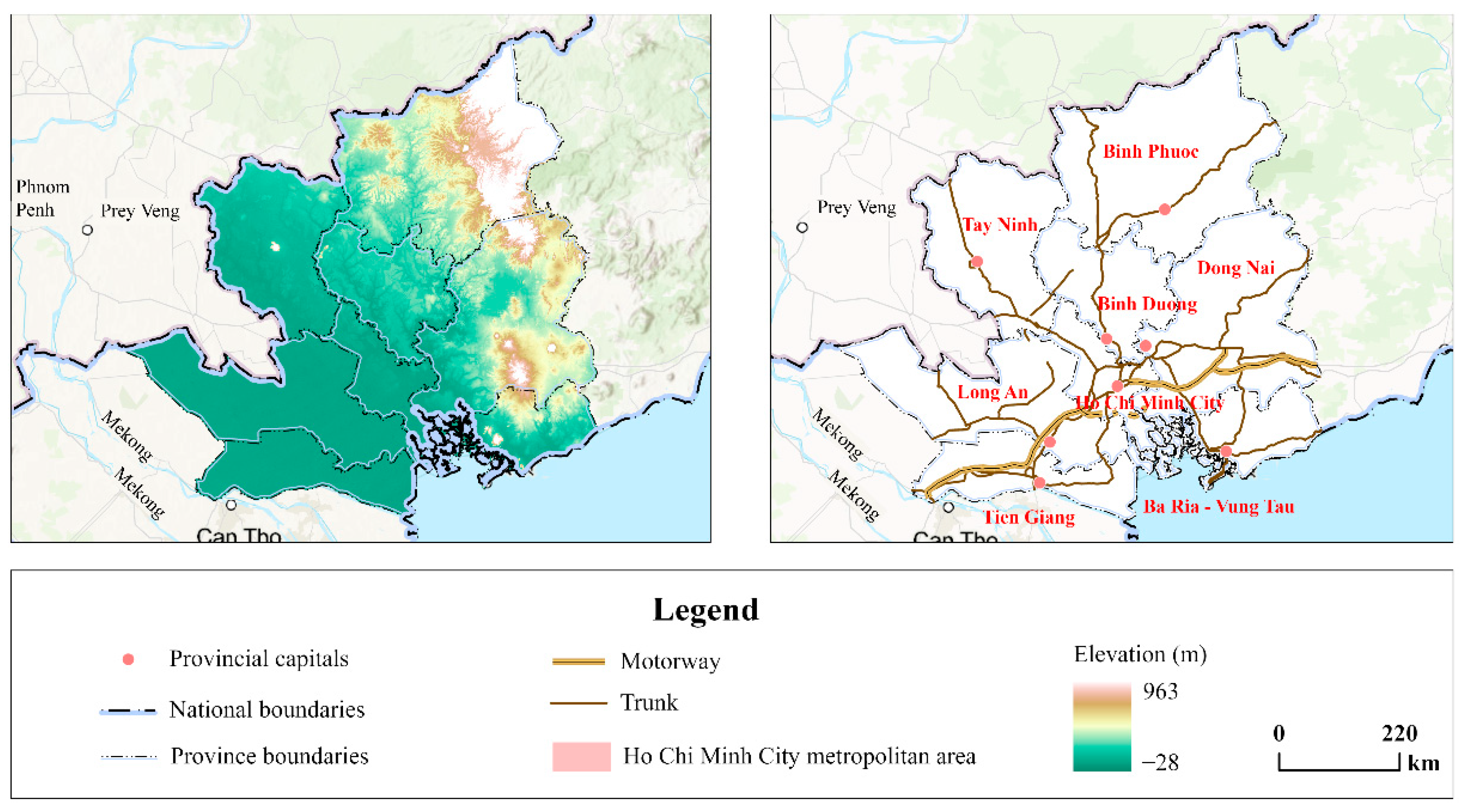
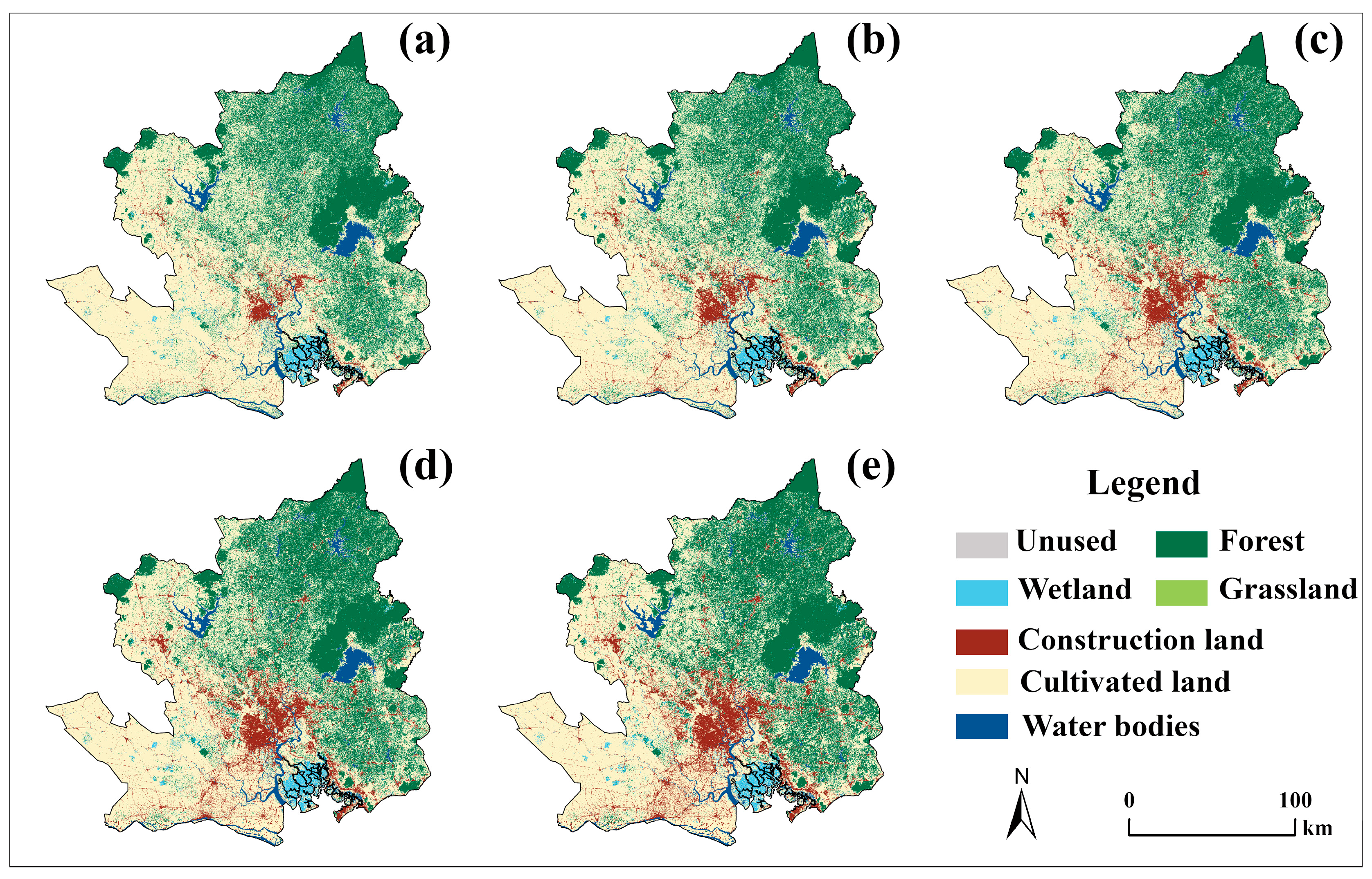
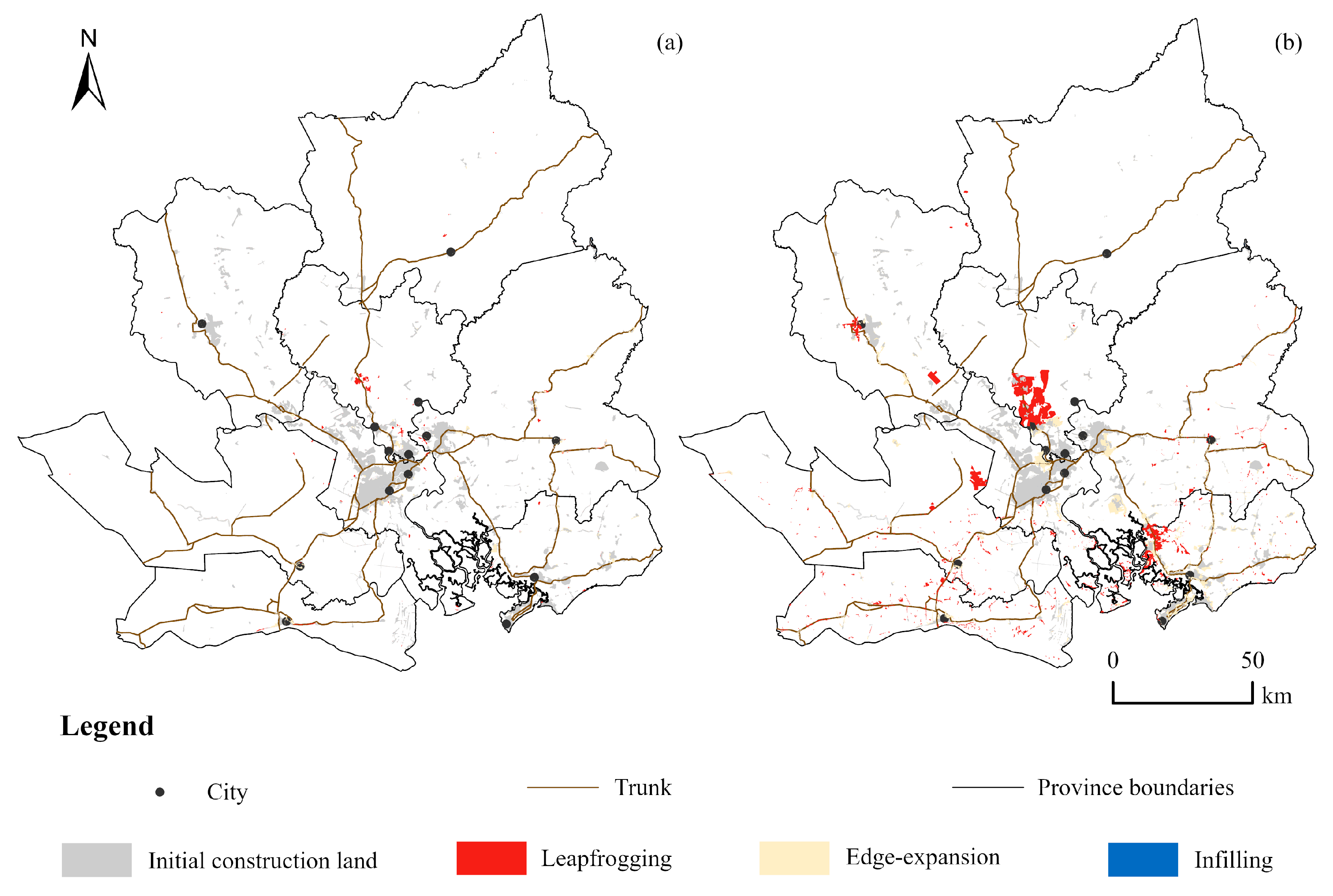


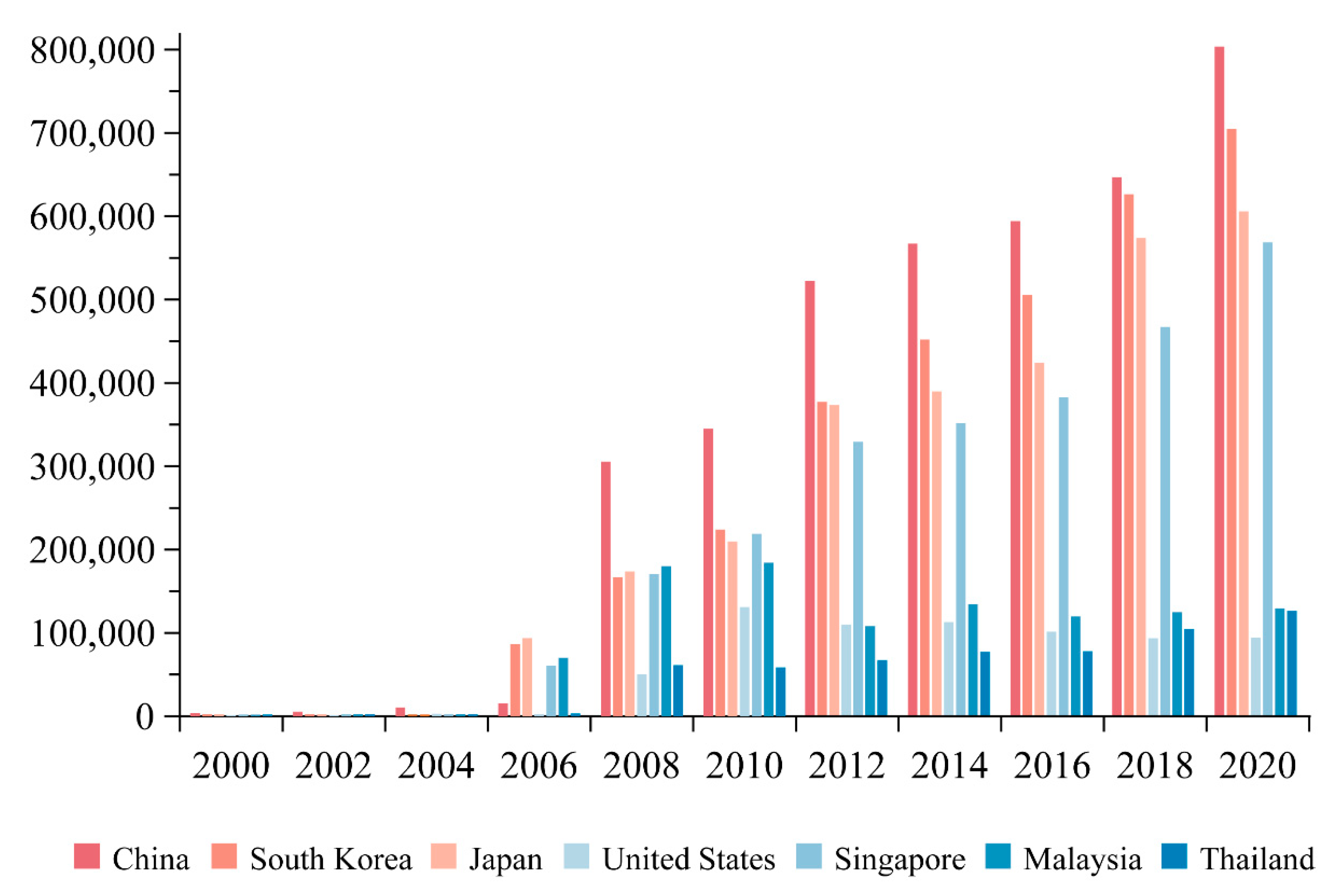
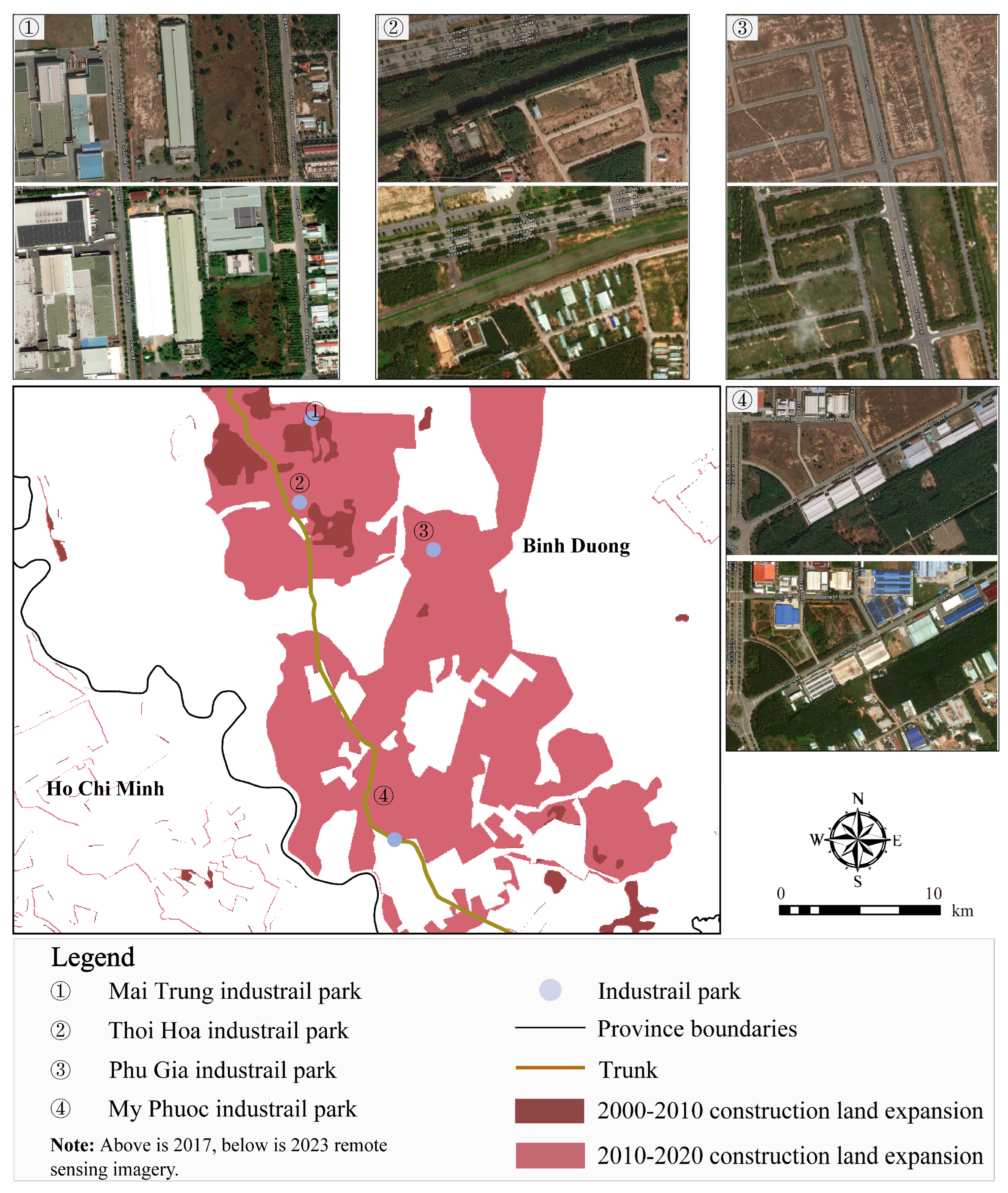
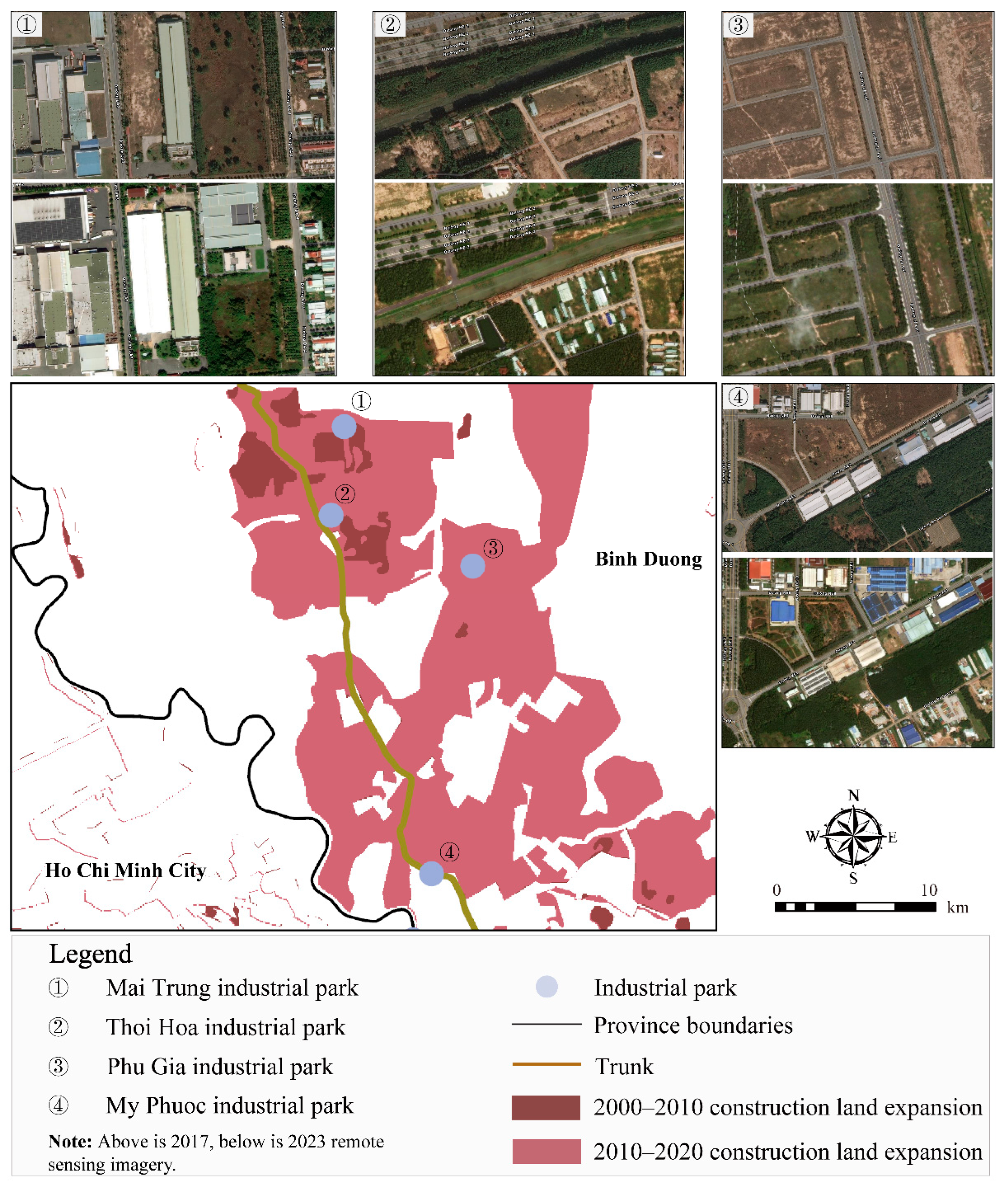
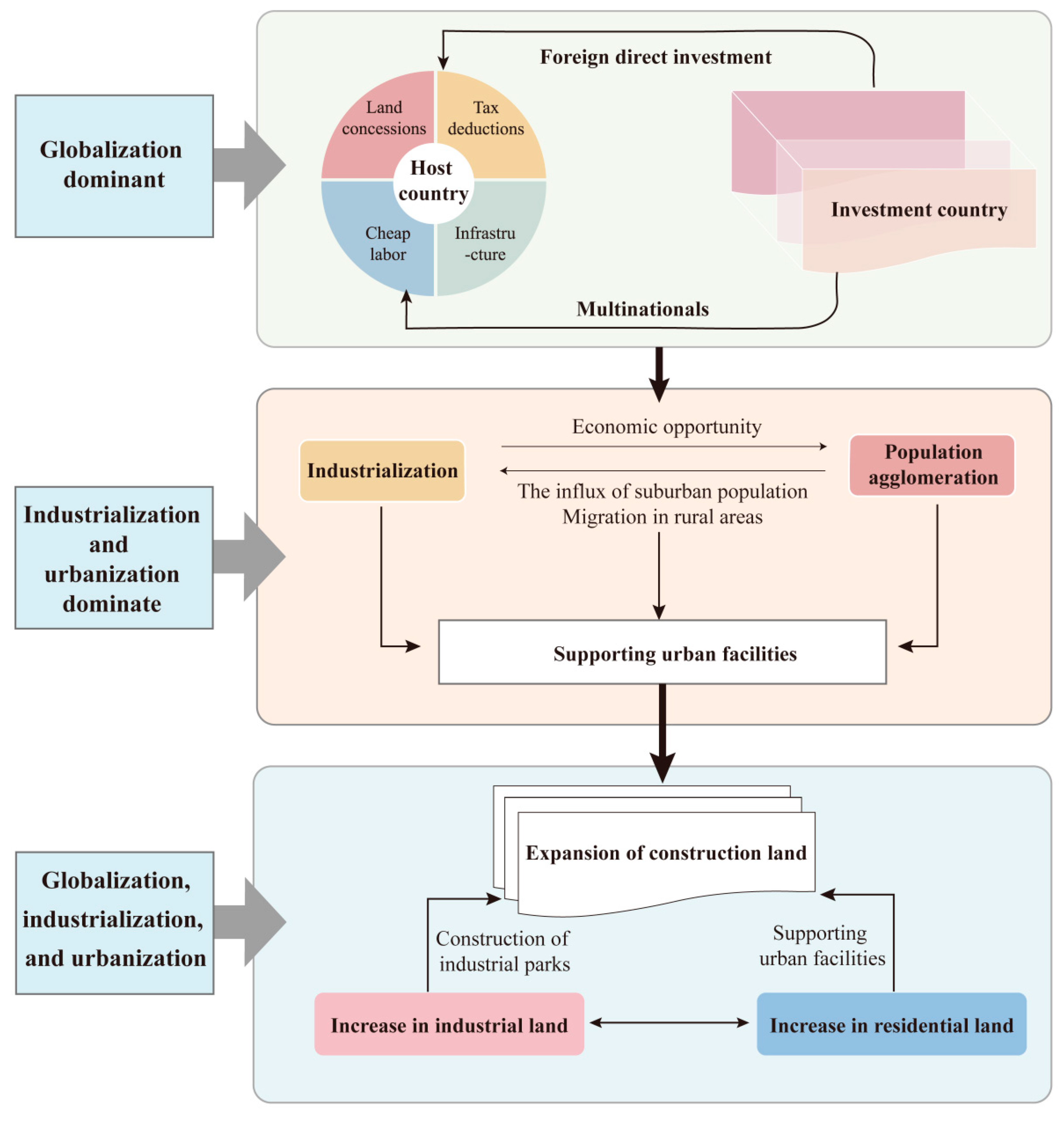
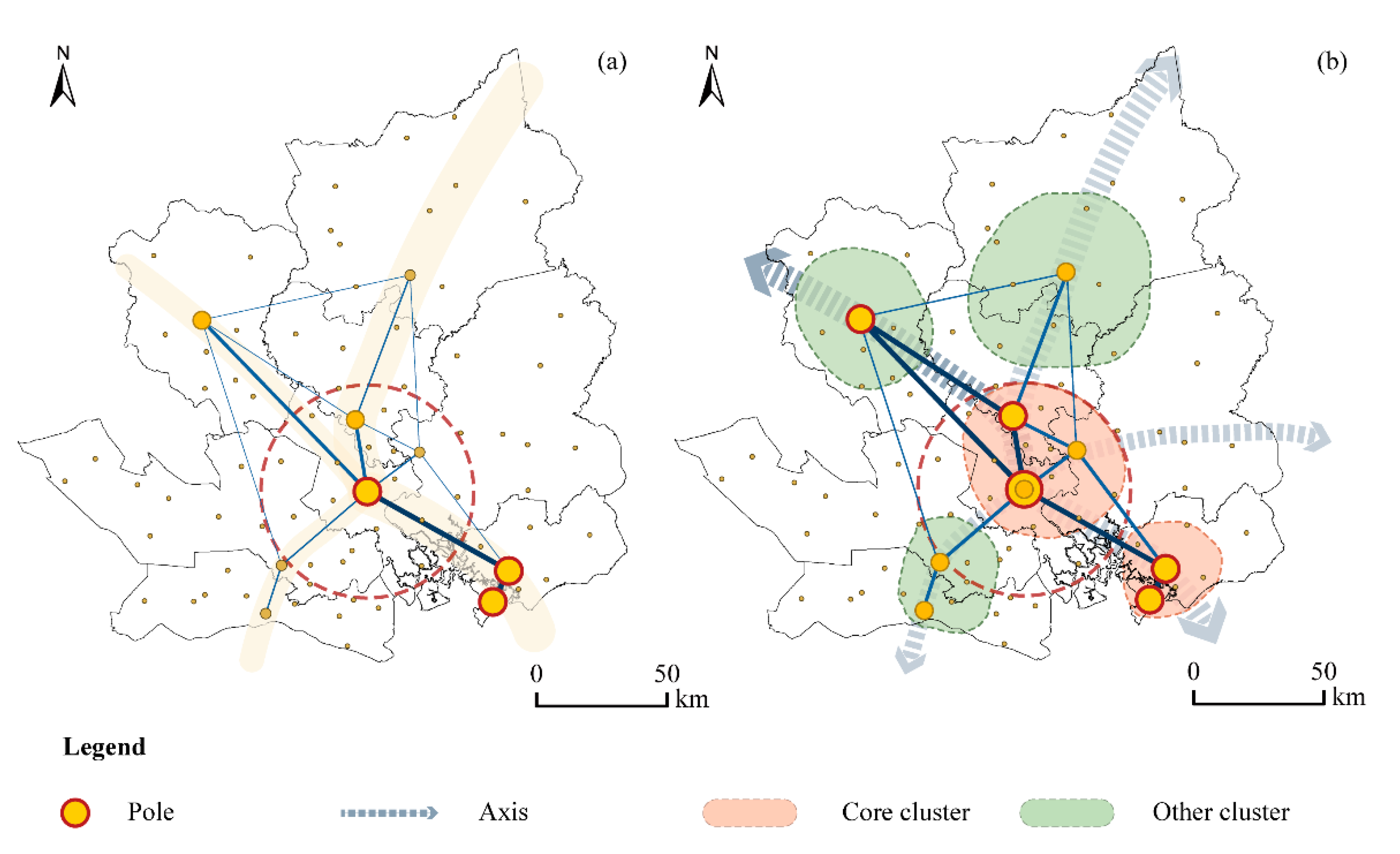
| Year | X Coordinate (Longitude) | Y Coordinate (Latitude) | Migration Distance (m) | Migration Rate (m/a) |
|---|---|---|---|---|
| 2000 | 106.65 | 10.76 | - | - |
| 2005 | 106.68 | 10.75 | 3643.31 | 728.66 |
| 2010 | 106.74 | 10.94 | 21,537.70 | 4307.54 |
| 2015 | 106.65 | 10.76 | 21,777.62 | 4355.52 |
| 2020 | 106.93 | 10.84 | 32,109.16 | 6421.83 |
| Variable | Type | Unit | |||
|---|---|---|---|---|---|
| Dependent variable | Y1-Changes in construction land (2000–2010) | 0 or 1 | 0–1 | ||
| Y2-Changes in construction land (2010–2020) | 0 or 1 | 0–1 | |||
| Independent variable | Natural background | Terrain | Elevation | Continuous | m |
| Slope | Continuous | ° | |||
| Globalization | Global investment | Foreign direct investment | Continuous | dollars | |
| Industrialization | Industrialization index | Industrialization index | Continuous | ||
| Industrial park | Distance to the industrial park | Continuous | km | ||
| Transport infrastructure | Distance to the trunk | Continuous | km | ||
| Distance to the primary road | Continuous | km | |||
| Distance to the secondary road | Continuous | km | |||
| Distance to the waterway | Continuous | km | |||
| Labor | Number of populations | Continuous | person | ||
| Urbanization | Capital city | Distance to the capital city | Continuous | km | |
| County | Distance to the county | Continuous | km | ||
| Nighttime light | Nighttime light | Continuous | |||
| Coef. | Robust Std. Err. z | t | P > |z| | |
|---|---|---|---|---|
| (a) 2000–2010 | ||||
| Elevation | 0.761 *** | 0.043 | 17.836 | 0.000 |
| Foreign direct investment | 0.417 *** | 0.087 | 4.769 | 0.000 |
| Distance to the industrial park | −0.372 *** | 0.124 | −3.009 | 0.003 |
| Distance to the trunk | −1.483 *** | 0.119 | −12.503 | 0.000 |
| Distance to the primary road | −0.891 *** | 0.114 | −7.808 | 0.000 |
| Distance to the secondary road | −1.939 *** | 0.194 | −10.019 | 0.000 |
| Number of populations | 0.202 *** | 0.027 | 7.485 | 0.000 |
| Distance to the capital city | 0.323 *** | 0.109 | 2.972 | 0.003 |
| Distance to the county | −0.875 *** | 0.167 | −5.242 | 0.000 |
| Nighttime light | 1.036 *** | 0.152 | 6.819 | 0.000 |
| (b) 2010–2020 | ||||
| Elevation | 0.316 *** | 0.045 | 7.018 | 0.000 |
| Industrialization index | −4.459 *** | 0.913 | −4.885 | 0.000 |
| Distance to the industrial park | −0.519 *** | 0.109 | −4.770 | 0.000 |
| Distance to the trunk | −1.548 *** | 0.106 | −14.631 | 0.000 |
| Distance to the primary road | −0.532 *** | 0.123 | −4.325 | 0.000 |
| Distance to the secondary road | −1.159 *** | 0.173 | −6.702 | 0.000 |
| Distance to the waterways | 0.547 *** | 0.124 | 4.400 | 0.000 |
| Number of populations | 0.220 *** | 0.029 | 7.623 | 0.000 |
| Distance to the capital city | −0.268 *** | 0.104 | −2.592 | 0.010 |
| Distance to the county | −0.547 *** | 0.157 | −3.487 | 0.000 |
| Nighttime light | 1.655 *** | 0.091 | 18.225 | 0.000 |
Disclaimer/Publisher’s Note: The statements, opinions and data contained in all publications are solely those of the individual author(s) and contributor(s) and not of MDPI and/or the editor(s). MDPI and/or the editor(s) disclaim responsibility for any injury to people or property resulting from any ideas, methods, instructions or products referred to in the content. |
© 2025 by the authors. Licensee MDPI, Basel, Switzerland. This article is an open access article distributed under the terms and conditions of the Creative Commons Attribution (CC BY) license (https://creativecommons.org/licenses/by/4.0/).
Share and Cite
Liang, Y.; Zhang, J.; Sun, W.; Guo, Z.; Li, S. Tracking the Construction Land Expansion and Its Dynamics of Ho Chi Minh City Metropolitan Area in Vietnam. Land 2025, 14, 1253. https://doi.org/10.3390/land14061253
Liang Y, Zhang J, Sun W, Guo Z, Li S. Tracking the Construction Land Expansion and Its Dynamics of Ho Chi Minh City Metropolitan Area in Vietnam. Land. 2025; 14(6):1253. https://doi.org/10.3390/land14061253
Chicago/Turabian StyleLiang, Yutian, Jie Zhang, Wei Sun, Zijing Guo, and Shangqian Li. 2025. "Tracking the Construction Land Expansion and Its Dynamics of Ho Chi Minh City Metropolitan Area in Vietnam" Land 14, no. 6: 1253. https://doi.org/10.3390/land14061253
APA StyleLiang, Y., Zhang, J., Sun, W., Guo, Z., & Li, S. (2025). Tracking the Construction Land Expansion and Its Dynamics of Ho Chi Minh City Metropolitan Area in Vietnam. Land, 14(6), 1253. https://doi.org/10.3390/land14061253








